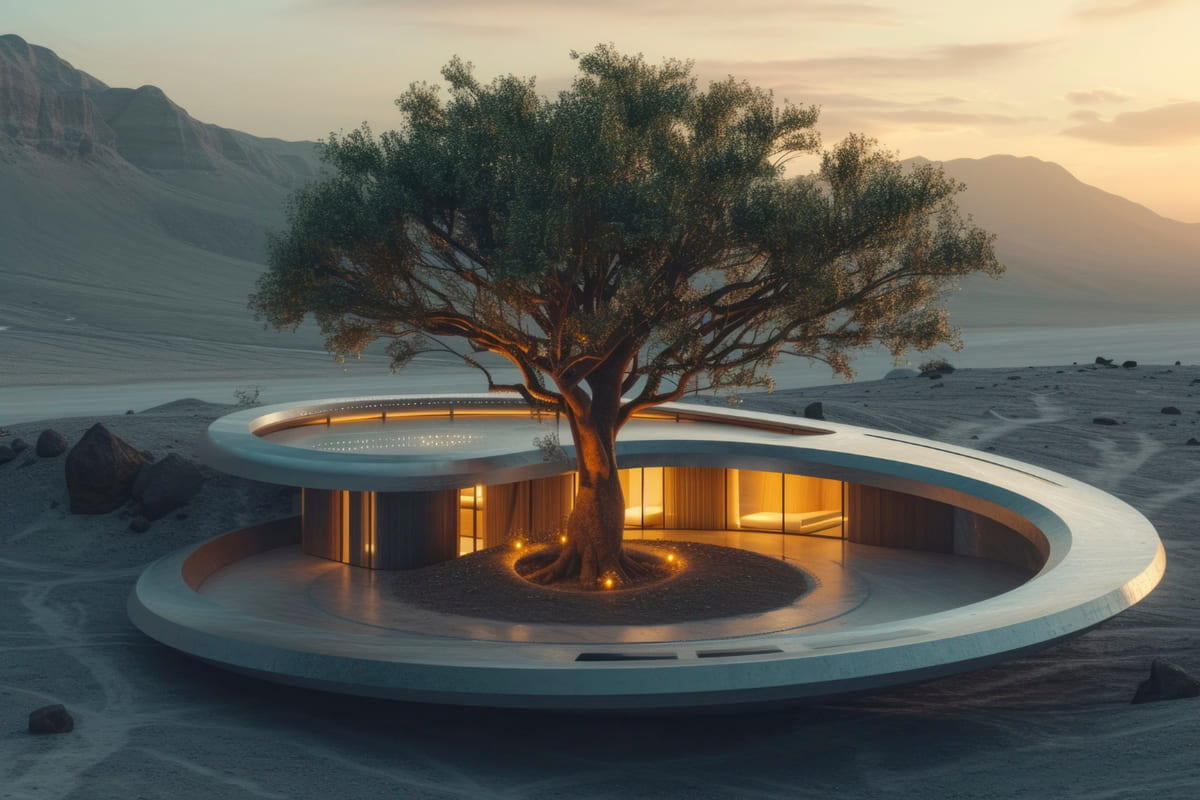AI architecture generator technologies are becoming increasingly popular in the ever-changing architectural landscape. Using modern AI technologies, an architect can improve productivity, improve design quality, and provide more creative and eco-friendly solutions. As AI advances, it is likely to play a significant role in architectural design. Popular AI architecture generators such as Midjourney, DALL-E, Stable Diffusion, and common ChatGPT plugins have already shown substantial results. In this post, we’ll look at ten developing AI tools and their impact on architectural design, from concept to visualization.
AI architecture generators help in the design process by eliminating time-consuming repetitive processes, allowing for quick prototyping, and generating insights from data that reduce mistakes and time waste in design. Rather than wasting hours on a feasibility study or a site analysis, architects may use AI tools to improve their work by providing real-time information that allows them to make the best decisions. This is especially true in complex projects that entail various variables such as zoning limitations, environmental concerns, and the aesthetic aspect of a design, all of which must be rigorously analyzed.
Suggested article to read: Artificial Intelligence or AI in Architecture; Guide to 2024
Table of Contents
AI Architecture Generators Definition
In the future, 2022 may be remembered as the year when generative artificial intelligence (AI) significantly impacted. Generative AI refers to a category of AI models capable of creating media content. These models generate content largely through user-generated text prompts, but they can also produce other types of media, such as photographs. For example, the user is required to enter prompts such as “Write a 1,000-word literature review of the psychological resilience literature from a theoretical perspective of human agency.”
AI architecture generator, dominated by LLMs and text-to-image models, is rapidly improving. Models for audio, video, and music may mature soon. Large Language Models (LLMs) like OpenAI’s GPT-3 and text-to-image models like Stable Diffusion have transformed the ability to generate data. Using ChatGPT and Stable Diffusion, it is now possible to generate natural-sounding text content and photorealistic graphics on unprecedented scale. These models have proven themselves capable of producing high-quality text and graphics.
How is AI Being Used in Architecture?
Architects, like many other professions, are scrambling to understand not just what the quickly expanding technology is capable of, but also the ethical and practical consequences of this strong new player in the design arena. Indeed, most major practices now have an expert on staff, and even small practices are experimenting with tools ranging from ChatGPT to complex visualization engines.
That last aspect, visualization, is likely the most popular AI architecture generator application right now. Whether it’s embellishing existing photographs with features like trees, people, and clouds, re-sampling images with different materials to “test” design alternatives, or simply creating entirely new images, the entrance barrier is quite low.

4 Main Ways to Use AI Architecture Generators
The profession is now conducting AI research and development (R&D). At this point, nothing is certain in terms of future efficiency gains, despite the presumption that they will be significant. AI architecture generator utilized in practices often falls into four categories:
1. Conceptual Designs
Image diffusion programs, such as Midjourney and Stable Diffusion, may generate breathtaking concept design graphics from word suggestions alone. However, Des believes that D5 Render is the most exciting technology right now because it already connects with CAD/BIM modelling platforms such as Rhino, Revit, SketchUp, and Archicad. Architects can use their early-stage models to apply stylistic iterations in real time, such as cycling through multiple material kinds and design revisions.
2. Design Ideas
The most common usage of AI architecture generator by practices is for visualisations of design ideas. Any licensed Photoshop user can now use the Generative Fill system, which is powered by Adobe’s Firefly AI engine, for example. It gives everyone instant visualisation skills.
So, if architects want to take an image part of a building and position it in a speculative landscape, possibly adding items like people and cars, they can now do so with a few language prompts. Specialist rendering abilities may no longer need to be outsourced for practices that do not provide this service.
3. Text Generation
ChatGPT is the AI chatbot that set off the AI avalanche just over a year ago. It is trained on generic online data – with set cut-off dates for scraped knowledge based on the version – and may be used as a research tool as well as a text generator/editor, reacting only to a sequence of refineable text prompts. ChatGPT is being used by practices to write and revise reports, summarise ideas for client presentations, fee proposals, application planning, and administrative chores such as HR operations.
4. Practice Archiving
Large practices with an R&D budget are beginning to use machine learning on their own data sets to train AI architecture generator engines based only on their back catalogue of designs, design approaches and stylistic methodologies, and their own libraries of information. This should streamline their own operations and offer a valuable resource while avoiding any potential copyright or authorship difficulties that may occur from sourcing content from the internet, rivals, or competitors.
How Can AI be Used to Foster Architectural Creativity?
AI architecture generator is transforming the architecture business by improving creativity, design optimization, and building processes. It may be applied to many various aspects of architecture to improve efficiency, design skills, and workflow.
AI may assist architects in a variety of ways, including fast exploring varied design choices, determining how buildings might be created in an energy efficient manner, automating operations such as 3D printing, and utilizing data and analytics to help make the decision-making process more efficient. These are only a few examples of how AI might benefit architecture, but in general, AI architecture generator helps to streamline process, boost efficiency, and stimulate creativity.
Emerging Technologies in Architecture to Complement AI
Here are 5 emerging technologies in the industry to complement AI architecture generator you must know about:
1. BIM
Building information modeling (BIM) is a more advanced 3D modeling technique that generates a digital representation of a building’s physical and functional attributes. BIM enables architects to automate repetitive operations and manage their whole design process, from concept to construction, in a single integrated platform, allowing them to make better decisions faster and more efficiently.
2. AR
Augmented reality is a technology that superimposes digital information and 3D visuals on actual items. Architecture firms can employ augmented reality to help clients make decisions by showing them exactly how the project will look before work begins.

3. 3D printing in Construction
3D printing is the simplest approach for architects to create prototypes and evaluate the feasibility of design proposals. This considerably speeds up operations and allows possible faults to be identified before they become a problem during the construction phase.
4. IoT
The Internet of Things (IoT) is a network of internet-connected objects that can communicate with one another. IoT technology is utilized in architecture to create smart buildings, giving users more control over energy use and system efficiency. IoT can also provide predictive maintenance for heating, ventilation, and air conditioning (HVAC) systems.
5. VR
Virtual reality can assist architects’ clients and other stakeholders better understand the design process. They can use a VR headset to explore the room in depth and observe how different materials appear before any real building takes place.
10 AI Architecture Generator that are Reshaping Design:
Here are 10 AI architecture generators that are reshaping the architectural design:
1. TestFit
TestFit is revolutionary for designers and architects, regardless if the work is residential, commercial, or both. Using its generative algorithms, it creates building layouts very quickly and efficiently upon given site conditions and zoning guidelines, allowing the testing of ideas and exploring the feasibility of projects. TestFit is also useful because of its ability to streamline processes that consume valuable time, such as the iterations of designing a floorplan, and offer real-time insights on the best possible design option in the shortest amount of time.
2. Archistar
Archistar is an exceptional AI architecture generator specializing in site analysis and feasibility assessment. Integrating geographic information system (GIS) data with generative design, efficiently helps in understanding site conditions, zoning codes, and market trends, offering architects a clear picture of the viability of the designed work. Archistar is very useful in minimizing the risk associated with site conditions, enabling the architects to make decisions that make the best use of land while complying with the law.

3. DeepBlocks
DeepBlocks simplifies the process of carrying out financial viability studies on large-scale projects. It integrates data from real estate markets, zoning, and economic modeling with AI to help architects and developers gauge the viability of projects. DeepBlocks offers in-depth information that assists architects in making project choices that are both cost-effective and architecturally pleasing. This is useful primarily in the case of big commercial and mixed-use developments, where the financial feasibility is just as important as the design quality.
4. Spacemaker AI
Spacemaker AI architecture generator enables architects to leverage insights derived from data on urban and interior space, layout and placement of buildings. This approach employs algorithms to process spatial, environmental, and zoning parameters to assist an architect in comprehending the impact of different conditions like sunlight, wind, and noise on building models. It allows constructions to be further optimized owing to accurate simulations, which is beneficial in urban design and design of high-rise buildings where every detail counts.
5. Kaedim
Kaedim is creative software that transforms 2D doodles into 3D models. Given its ability to intelligently convert mere sketches into complex 3D works, Kaedim is suitable for designers, especially architects who need to visualize preliminary concepts within a limited time. Furthermore, this tool allows architects to evaluate and refine design ideas faster and in a more progressive manner. It is also easy to use and integrates well with most design programs, which makes it a crucial tool for shaping architectural design.
6. Hypar
Hypar focuses on parametric modeling and generative design through automation of the design process. Letting architects specify a building’s height, usage type, and environmental factors, this AI architecture generator algorithms generate the most suitable layouts of the buildings. This tool is most useful for larger projects where issues such as circulation and efficiency of space are of great importance. Thus, Hypar aids designers in coming up with comprehensive designs that adhere to the regulations and minimize the time taken in manual alterations of the designs.
7. Archivinci
This AI architecture generator assists in the preparation of conceptual designs and 3D visuals for architects during the initial phases of design. It employs AI to analyze design inputs to come up with new ideas that fulfill the requirements of the project. This tool allows for rapid visualization and modification of design concepts within the confines of a brainstorming session and presentation for the initial stage with clients. The robust function and user-friendly interface of Archivinci would enhance any architectural design.

8. ArchVizz
ArchViz employs AI to enhance the speed of rendering and visualizing architectural designs. It provides architects with the tools to create breathtaking 3D walkthroughs and renders, which, in turn, improves the way they present and discuss design ideas.ArchVizz utilizes advanced AI algorithms to render designs that are not only accurate but also realistic, which aids in successfully communicating design intent. Its interface is easy to use, and it works well with other design tools, making it a useful tool for architects.
9. Rendair
This AI architecture generator is an online-based AI architecture generator designed for architects to help them produce high-quality renderings in real time. Its strong AI algorithms assist in generating 3D renders from simple 2D drawings; thus, the rendering time is reduced significantly. By playing with materials, lighting, and textures, architects can easily create realistic models that are ideal for client interaction and presentations. This is an essential AI tool in modern architectural firms, largely due to its ease of use and powerful processing in the cloud.
10. Veras
Veras revolutionizes architectural visualization by improving the quality of renders and shortening post-production work. It employs AI-based filters that modify lighting, textures, and realism, enabling architects to prepare completed visuals for presentations to clients. This AI architecture generator is helpful in improving renders with little effort, reducing the work done manually while still achieving a high visual standard. This application comes in handy, especially for design groups that want to produce stunning graphics within a very short period of time with minimal or no rendering.
What are the Next Steps for AI Architecture Generators?
Where is all of this going? Of course, there are crucial arguments to be made about contractual implications, copyright infringement (where is your preferred engine scraping its information), fee calculations, and etiquette (should you watermark each image or paper created using AI?).
Having said that, some major events in the near future. Consider text-to-BIM and 3D-form generators, for example. And, despite having the means to early adopt and even develop their own AI architecture generators, he does not believe that major practices with R&D budgets will always have an advantage in the AI future.
One of the potential benefits of AI is that it can help streamline procedures and make firms more productive. And this could be beneficial for smaller practices. Whatever the future holds in this fast changing world, the aim is that AI, like CAD and BIM before it, will collaborate with and benefit humans, rather than the other way around.
FAQs
What is an AI architecture generator?
- Answer: An AI architecture generator is a program that uses artificial intelligence to help create architectural designs, concept visuals, and feasibility assessments. It automates monotonous operations, generates design concepts, and optimizes building layouts using data-driven insights.
What are some popular AI architecture generators?
- Answer: Midjourney, DALL-E, Stable Diffusion, TestFit, Archistar, DeepBlocks, Spacemaker AI, Kaedim, Hypar, Archivinci, and ArchVizz are a few popular AI architecture generators. These tools help with concept generation, site investigation, financial modeling, and visualization.
How is AI being used in architecture today?
- Answer: AI is used in architecture to design concepts, visualize data, generate text, and archive practice sessions. It aids in the creation of early-stage design concepts, the improvement of 3D renders, the drafting of reports, and the training of AI models with previous project data.
Can AI help architects with zoning and site analysis?
- Answer: Yes, AI systems such as Archistar and Spacemaker AI examine zoning rules, environmental considerations, and urban data to assist architects in determining project feasibility and optimizing site use.
What role does AI play in architectural visualization?
- Answer: AI-powered tools improve visualization by producing realistic renders, altering photographs with various materials, and building immersive 3D settings. ArchVizz is a tool that helps architects express design ideas more effectively.
Conclusion
The architecture industry is undergoing a significant transformation, driven by the introduction of AI architecture generator. From automating repetitive tasks to creating innovative design ideas, AI architecture generator is changing the way architects approach every stage of the design and construction process.
AI’s impact is not purely theoretical; it is transforming real-world projects and allowing architects to address urgent issues such as climate adaptability and resource efficiency. In this blog, we’ll look at the advantages, use cases, and real-world examples of how AI is transforming the discipline of architecture.
31 AI Tools for Architectural Design; 2025 Ultimate Guide
Top 10 Construction Companies in Malaysia 2025
What are Building Technologies? 2025 Ultimate Guide
14 Saudi Arabia Giga Projects; Vision 2030
What is ConTech (Construction Technology)? 2025 Review + Examples
13 Best UK Architecture Firms You Should Know About in 2025
Resources:
digitalbluefoam | dezeen | architecture | nemetschek | forbes | abc | architectmagazine | openasset
For all the pictures: Freepik





